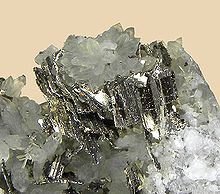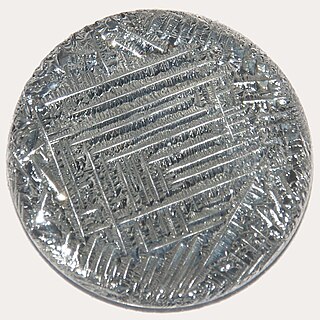
Tellurium is a chemical element; it has symbol Te and atomic number 52. It is a brittle, mildly toxic, rare, silver-white metalloid. Tellurium is chemically related to selenium and sulfur, all three of which are chalcogens. It is occasionally found in its native form as elemental crystals. Tellurium is far more common in the Universe as a whole than on Earth. Its extreme rarity in the Earth's crust, comparable to that of platinum, is due partly to its formation of a volatile hydride that caused tellurium to be lost to space as a gas during the hot nebular formation of Earth.
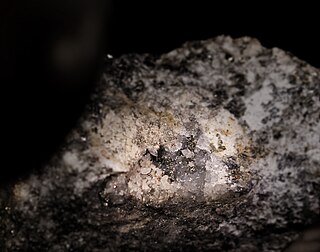
The mineral petzite, Ag3AuTe2, is a soft, steel-gray telluride mineral generally deposited by hydrothermal activity. It forms isometric crystals, and is usually associated with rare tellurium and gold minerals, often with silver, mercury, and copper.

Sylvanite or silver gold telluride, chemical formula (Ag,Au)Te2, is the most common telluride of gold.
The telluride ion is the anion Te2− and its derivatives. It is analogous to the other chalcogenide anions, the lighter O2−, S2−, and Se2−, and the heavier Po2−.
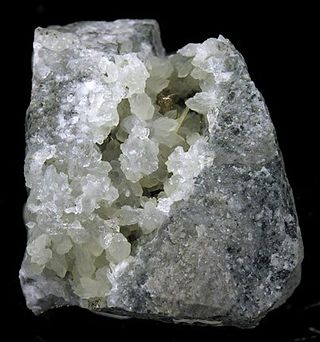
Krennerite is an orthorhombic gold telluride mineral which can contain variable amounts of silver in the structure. The formula is AuTe2, but specimen with gold substituted by up to 24% with silver have been found ([Au0.77Ag0.24]Te2). Both of the chemically similar gold-silver tellurides, calaverite and sylvanite, are in the monoclinic crystal system, whereas krennerite is orthorhombic.
Weissite is a telluride mineral, a copper telluride. Its chemical formula is Cu
2−xTe. Weissite has hexagonal crystal structure. Its specific gravity is 6 and its Mohs hardness is 3. Occurrence is in Gunnison County, Colorado, Arizona and New Mexico in the United States. It is also reported from Kalgoorlie, Western Australia and Dalarna and Värmland, Sweden.

Melonite is a telluride of nickel; it is a metallic mineral. Its chemical formula is NiTe2. It is opaque and white to reddish-white in color, oxidizing in air to a brown tarnish.
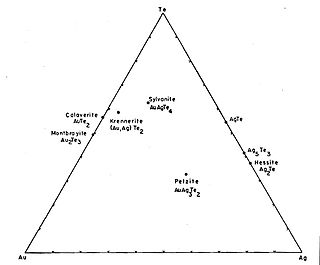
A telluride mineral is a mineral that has the telluride anion as a main component.

Tellurobismuthite, or tellurbismuth, is a telluride mineral: bismuth telluride (Bi2Te3). It crystallizes in the trigonal system. There are natural cleavage planes in the (0001) direction as the crystal is effectively lamellar (layered) in that plane. The Mohs hardness is 1.5 - 2 and the specific gravity is 7.815. It is a dull grey color, which exhibits a splendent luster on fresh cleavage planes.

Nagyágite is a rare sulfide mineral with known occurrence associated with gold ores. Nagyágite crystals are opaque, monoclinic and dark grey to black coloured.
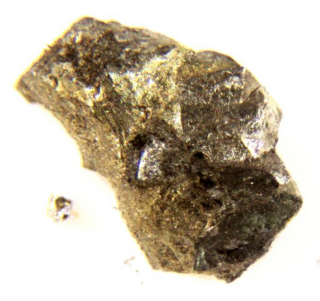
Vulcanite is a rare copper telluride mineral. The mineral has a metallic luster, and has a green or bronze-yellow tint. It has a hardness between 1 and 2 on the Mohs scale. Its crystal structure is orthorhombic.
Gold chalcogenides are compounds formed between gold and one of the chalcogens, elements from group 16 of the periodic table: oxygen, sulfur, selenium, or tellurium.

Coloradoite, also known as mercury telluride (HgTe), is a rare telluride ore associated with metallic deposit. Gold usually occurs within tellurides, such as coloradoite, as a high-finess native metal.

Zemannite is a very rare oxide mineral with the chemical formula Mg0.5ZnFe3+[TeO3]3·4.5H2O. It crystallizes in the hexagonal crystal system and forms small prismatic brown crystals. Because of the rarity and small crystal size, zemannite has no applications and serves as a collector's item.

Stützite or stuetzite is a silver telluride mineral with formula: Ag5−xTe3 (with x = 0.24 to 0.36) or Ag7Te4.

Pearceite is one of the four so-called "ruby silvers", pearceite Cu(Ag,Cu)6Ag9As2S11, pyrargyrite Ag3SbS3, proustite Ag3AsS3 and miargyrite AgSbS2. It was discovered in 1896 and named after Dr Richard Pearce (1837–1927), a Cornish–American chemist and metallurgist from Denver, Colorado.

The mineral uytenbogaardtite, Ag3AuS2, is a soft, greyish white sulfide mineral, occurring in hydrothermal Au-Ag-quartz veins. It occurs as tiny crystals, visible only with a microscope. It has a metallic luster and a hardness on the Mohs scale of 2 (gypsum).

Molybdenum(IV) telluride, molybdenum ditelluride or just molybdenum telluride is a compound of molybdenum and tellurium with formula MoTe2, corresponding to a mass percentage of 27.32% molybdenum and 72.68% tellurium.
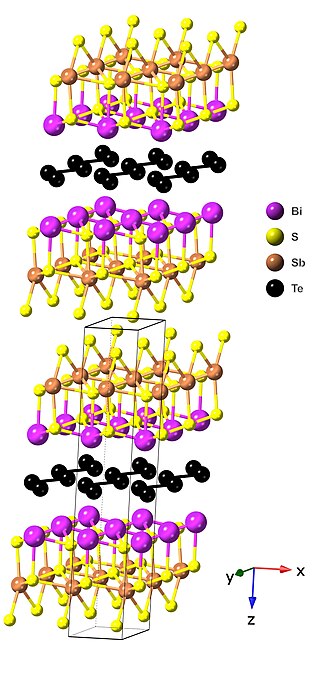
Kanatzidisite is a mineral of the sulfosalt class with a composition of [BiSbS3][Te2]. It crystallizes in the monoclinic crystal system (space group: P21/m) with lattice constants a = 4.0021(5) Å, b = 3.9963(5) Å, c = 21.1009(10) Å and β = 95.392(3)°. Its structure features very unusual van der Waals heterolayers of alternating BiSbS3 double layers and atomically thin distorted [Te2] square-net. Based on its calculated band structure, kanatzidisite may exhibit topological features characteristic of a Dirac semimetal. Associated minerals are arsenopyrite, pyrite, marcasite, sphalerite, chalcopyrite, gold, bismuth, bismuthinite, ikunolite, jonassonite, jaszczakite ([(Bi,Pb)3S3][AuS2]) and cosalite in a quartz matrix. A mineral specimen was detected by Luca Bindi and is currently stored in the Museum of Natural History of the University of Florence in Italy. The name of kanatzidisite is after Mercouri Kanatzidis, a distinguished chemist who holds the position of Professor of Chemistry at Northwestern University and Senior Scientist at Argonne National Laboratory.
Daliranite is a sulfosalt found in northwestern Iran with a general chemical formula of PbHgAs2S5. The mineral presents a vibrant orange-red color and fibrous habit which makes it resemble the oxide ludlockite being confused by its similarities in early studies. Named after Dr. Farahnaz Daliran, who has important contributions to research on ore deposits in Iran, this mineral was accepted by the International Mineralogical Association (IMA) in 2007.


